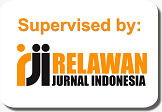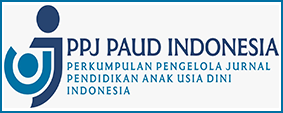THE ACQUISITION OF ENGLISH VOCABULARY BY KINDERGARTEN STUDENTS THROUGH CHILDREN SONGS
Abstract
This research focuses on how the process of students in acquiring language. This study aims to find out kinds of vocabulary that the young learners acquire through children song and analyze how the internal and external factors influence the process of language acquisition. The data in this study were 10 students from Hooray School In collecting the data, observation method and questioners were used. Observation was conducted for three weeks and post-test is given to the students in the last meeting of each week. Questioners is given to the students’ parents to know information about factors influence the students in learning English. The result of this study showed that English children songs are effective media to be used in acquiring language for children. In this study, there are 2 songs introduced to the students. From the lyrics of those songs, they are able to acquire English vocabularies, such as shark, octopus, jellyfish, turtle, dolphin, seahore, swim, and sea. In acquiring languages, the students are influenced by some factors. The internal factors are age, experience and learning style. The external factors consist of motivation, instruction and access to foreign speakers. The students who are surrounded by an English speaking environment learn English vocabularies faster and easier than the other students who are not surrounded by an English speaking environment.
References
ASHA. (2020). American Speech Language Hearing Association. Speech-Language-Hearing Association (ASHA).
Brown, H. D. (2000). Principles of Language Learning and Teaching. Longman.
Chomsky Nuam. (1965). Aspects of the theory of Syntax. Cambridge. The MIT Press.
Connell, P. J. (1987). Teaching language rules as solutions tolanguage problems: A baseball analogy. Language, Speech,and Hearing Services in Schools.
Curtis, M. (2004). A sailor went to sea: Theme and variations. Folk Music Journal.
Fillmore, L. W., & Snow, C. E. (2018). What Teachers Need to Know About Language. Multilingual Matters.
Hasa. (2020). Difference Between First Language and Second Language Acquisition. PEDIAA. https://pediaa.com/difference-between-first-language-and-second-language-acquisition/#:~:text=sentences to communicate.-,First language acquisition is children’s acquisition of their native language,an active and conscious process.
Kurniati, V. S. D., & Widyastuti, I. (2019). Developing English Children Learning Media through Lyrics Visualization Developing English Children Learning Media through Lyrics Visualization. International Conference on Technology, Education and Sciences (InCoTES), 1(1), 122–129.
Noam Chomsky. (1972). Language and Mind. Harcourt Brace Jovanovich. Inc.
Sharon Novak. (2014). What Are the Characteristics of a Good Kids Song. Https://Www.Linkedin.Com/. https://www.linkedin.com/
Sugiyono. (2009). Metode Penelitian Pendidikan Pendekatan Kuantitatif, Kualitatif, dan R&D. Bandung : Alfabeta.
Wiasti, N. K. (2021). SEKAR RARE SEBAGAI MEDIA PEMBELAJARAN NILAI. Kumarottama: Jurnal Pendidikan Anak Usia Din, 1(1), 36–48. https://doi.org/https://doi.org/https://doi.org/10.53977/kumarottama.v1i1.267
Wiguna, Ida Bagus Alit & Ekaningtyas, N. L. D. (2021). STRATEGI ORANG TUA DALAM MENDAMPINGI ANAK USIA DINI BELAJAR DARING DI RUMAH. PRATAMA WIDYA: JURNAL PENDIDIKAN ANAK USIA DINI, 6(1), 86-95. http://www.ejournal.ihdn.ac.id/index.php/PW/article/view/2141
Wiguna, I. B. A. A. (2020). Efektivitas Penerapan Metode Hypnoteaching Dalam Meningkatkan Aktivitas Belajar Siswa. PEMBELAJAR: Jurnal Ilmu Pendidikan, Keguruan, Dan Pembelajaran, 4(2). https://doi.org/10.26858/pembelajar.v4i2.13006
Wiguna, I. B. A. A. (2021). Pelatihan Dan Pengembangan Keterampilan Mengajar Guru Pendidikan Anak Usia Dini. SELAPARANG Jurnal Pengabdian Masyarakat Berkemajuan, 4(3), 533. https://doi.org/10.31764/jpmb.v4i3.4434

This work is licensed under a Creative Commons Attribution-ShareAlike 4.0 International License.
Authors who publish with this journal agree to the following terms:
- Authors retain copyright and grant the journal right of first publication with the work simultaneously licensed under a Creative Commons Attribution-ShareAlike 4.0 International License that allows others to share the work with an acknowledgement of the works authorship and initial publication in this journal.
- Authors are able to enter into separate, additional contractual arrangements for the non-exclusive distribution of the journals published version of the work (e.g., post it to an institutional repository or publish it in a book), with an acknowledgement of its initial publication in this journal.
- Authors are permitted and encouraged to post their work online (e.g., in institutional repositories or on their website) prior to and during the submission process, as it can lead to productive exchanges, as well as earlier and greater citation of published work (See The Effect of Open Access).











.png)














